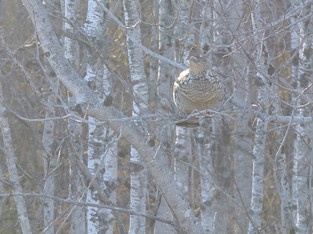71st year of counts continues, and second year of West Nile virus sampling shows similar results
Minnesota’s ruffed grouse spring population counts are similar to last year and likely are following the 10-year cycle of rise and fall—a predictable pattern recorded for 71 years.

Due to COVID-related restrictions, this past spring’s drumming counts in southeastern Minnesota were not conducted as planned. As the DNR was able to resume more field operations in May, there was still time to conduct drumming counts in more northerly portions of the state, where the peak in drumming activity occurs later.
While spring drumming counts that were conducted produced similar results as last year, only having counts from the northern region—which has more forest and holds more grouse—likely means the statewide index is higher than it would be if the southeastern region was included.
Some consider the ruffed grouse the “king of game birds” because it’s a challenge to pursue, a thrill to witness on the wing and a delicious wild game entrée when served. These birds are native to Minnesota—the top ruffed grouse-producing state in the coterminous United States, with millions of acres of public land for hunters and their dogs to explore.
The spring drumming counts are an important indicator of the ruffed grouse breeding population. However, the number of birds present during the fall hunting season also depends upon nesting success and chick survival during the spring and summer.
If production of young birds is low during the summer months, hunters may see fewer birds than expected based on counts of drumming males in the spring. Conversely, when production of young is high, hunters may see more birds in the fall.
The 2020 survey results for ruffed grouse were 1.6 drums per stop. The averages during 2015, 2016, 2017, 2018 and 2019 were 1.1, 1.3, 2.1, 1.5 and 1.6 respectively. Counts vary from about 0.6 drums per stop during the years of cyclical low grouse abundance to about 2.0 during years of high abundance.
Drum counts were 1.7 drums per stop in the northeast survey region; counts were 1.2 drums per stop in the northwest; 1.2 drums per stop in the central hardwoods; and no routes were completed during the appropriate survey window in the southeast survey region.
Drumming is a low sound produced by males as they beat their wings rapidly and in increasing frequency to signal the location of their territory. Drumming displays also attract females that are ready to begin nesting. Ruffed grouse populations are surveyed by counting the number of male ruffed grouse heard drumming on established routes throughout the state’s forested regions.
“In a typical year we have 16 cooperating organizations providing folks to help us count grouse drumming,” Roy said. “We are grateful to our federal and tribal partners, some of whom conducted extra routes to get surveys completed during the pandemic.”
Biologists were not able to collect sharp-tailed grouse survey data this year during the pandemic.
West Nile virus results
Test results in from the second year of a study on West Nile virus in ruffed grouse showed similar results to the previous year. Antibodies consistent with virus exposure were detected in 12.3 percent of the 317 samples submitted by hunters in 2019. This compares with a 12.5 percent antibody rate in the 273 samples submitted by hunters in 2018.
“West Nile virus exposure is lower in Minnesota than in other states where exposure has been studied, which may reflect the abundance and quality of grouse habitat in Minnesota,” Roy said.
West Nile virus is carried by infected mosquitoes. Not all people or animals bitten by an infected mosquito will contract West Nile virus. There have been no documented cases of people contracting West Nile virus from consuming properly cooked meat.
West Nile virus has been present in Minnesota since the early 2000s, but interest in effects on ruffed grouse increased following a study in Pennsylvania documenting relationships between habitat quality, populations and virus exposure. Some bird species recover quickly and become tolerant to the virus while others, such as blue jays and crows, suffer higher rates of mortality. The Minnesota grouse hunting season opens on Saturday, Sept. 19. More information about ruffed grouse hunting and sampling, the grouse survey report and West Nile virus is available on the DNR grouse hunting page.
Last modified: 08/12/2020











